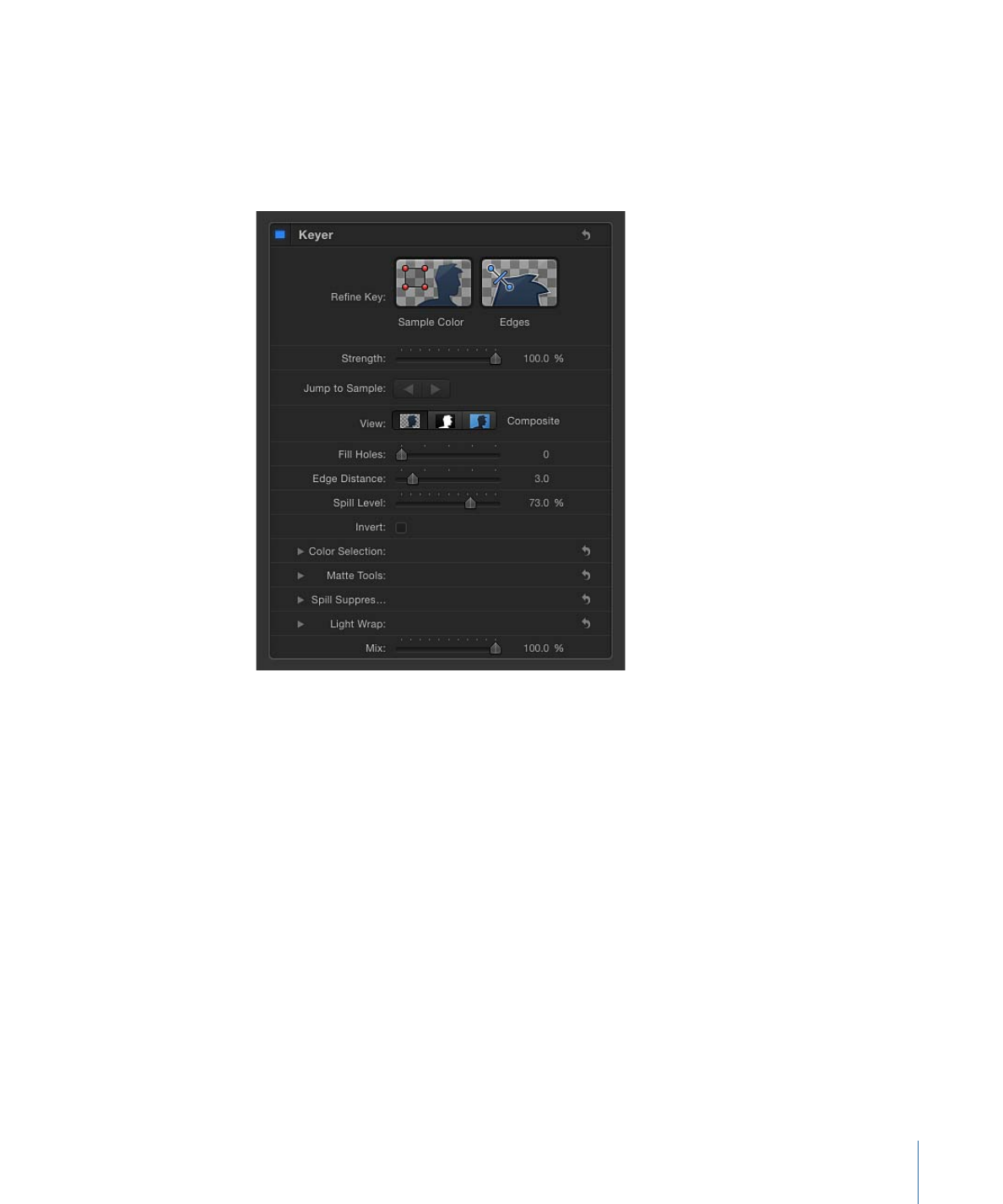
Keyer
After you apply the Keyer filter to a video or image layer in your project, you can modify
and refine the keying parameters in the Filters Inspector or HUD. This section explains
the operation of the tools and parameter controls found in the Keyer section of the Filters
Inspector.
Parameters in the Inspector
Refine Key:
Use the Refine Key tools to manually sample regions of an image to modify
the tolerance, or core transparency, of the generated key. You can sample multiple regions
in an image or in a single frame of a movie clip. You can also sample regions across
multiple frames of a clip or image sequence to compensate for changing conditions, such
as shifting lighting that affects the keyed background.
When you sample regions in multiple frames, keyframes are added to interpolate the
difference from one frame to the next. (Unlike standard keyframes, color-sampling
keyframes are hidden in the Motion workspace by default.) The Jump to Sample buttons
let you navigate between frames you’ve sampled, to make changes. For more information
on keyframing the Keyer filter, see
Animating Parameters in the Keyer Filter
.
There are two Refine Key tools:
• Sample Color: Use this tool to select regions of the image to be turned transparent.
Click the Sample Color tool, then drag a selection box in the Canvas to define a range
of color to key.
637
Chapter 13
Keying
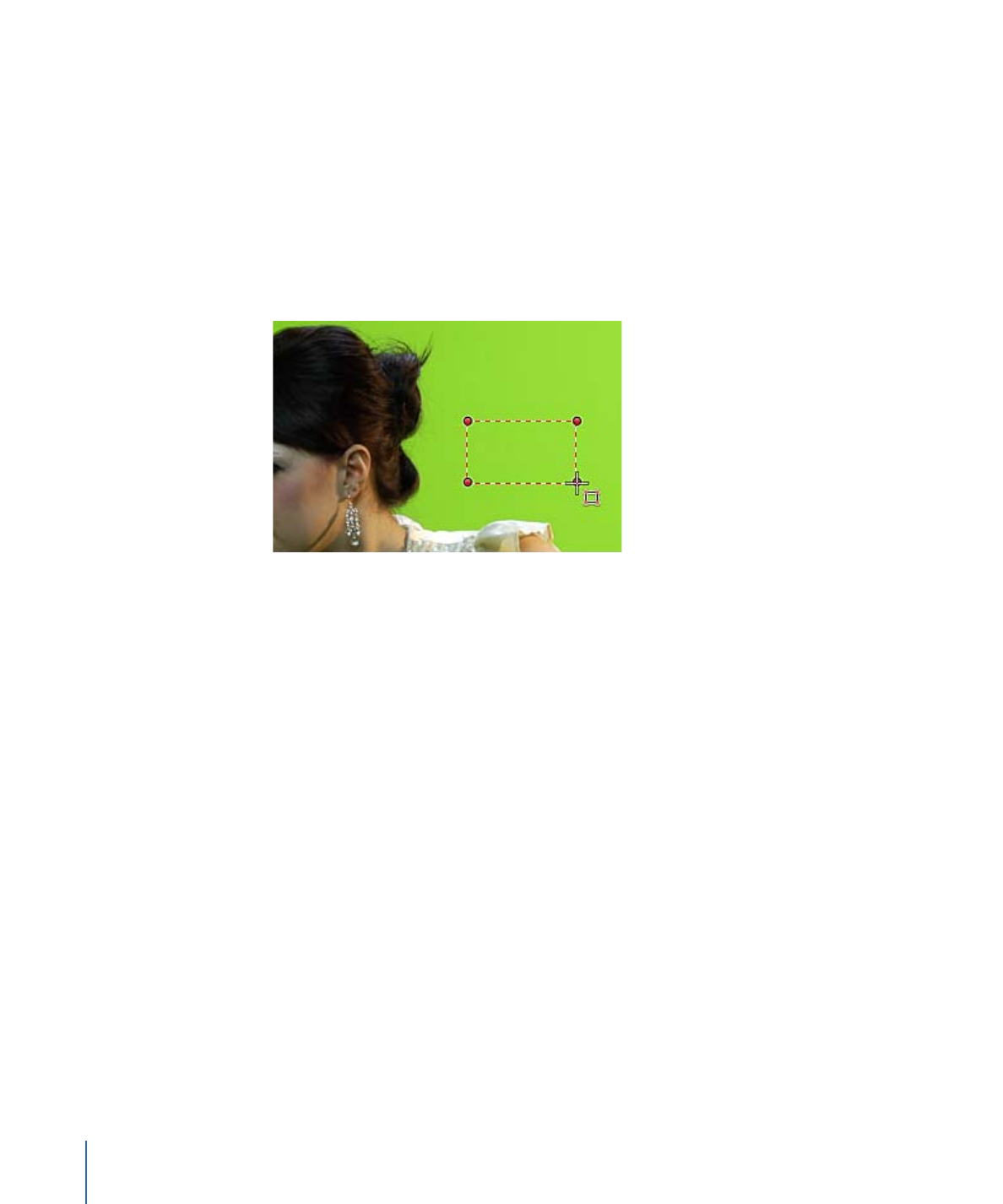
After you create a selection box, you can resize it to sample more or fewer shades of
color, increasing or decreasing the range of background color used to create
transparency. You can also add more selection boxes to expand the range of color that
is keyed. You can also add more sample color boxes at other frames of the clip to
maintain transparency when lighting conditions change.
To add selection boxes, select the Keyer filter in the Layers list, then hold down the
Shift key while dragging in the Canvas.
Note: Adding a Sample Color selection box to a frame adds to the sampled region
that’s defined when you first apply this filter.
• Edges: Use this tool to refine the transparency of marginal regions of the keyed subject,
such as hair, reflections, smoke, or moving subjects with motion blur. Click the Edges
tool, then drag in the Canvas to draw a line that crosses the boundary of the
semitransparent region you want to adjust (with one point on the keyed foreground
subject and the other point on the transparent background). Next, adjust the slider
handle in the middle of this control line, outward to soften the matte, or inward to
harden it.
If the Keyer filter is selected in the Layers list, you can press the Command key and drag
in the Canvas to create Edges sampling controls.
638
Chapter 13
Keying
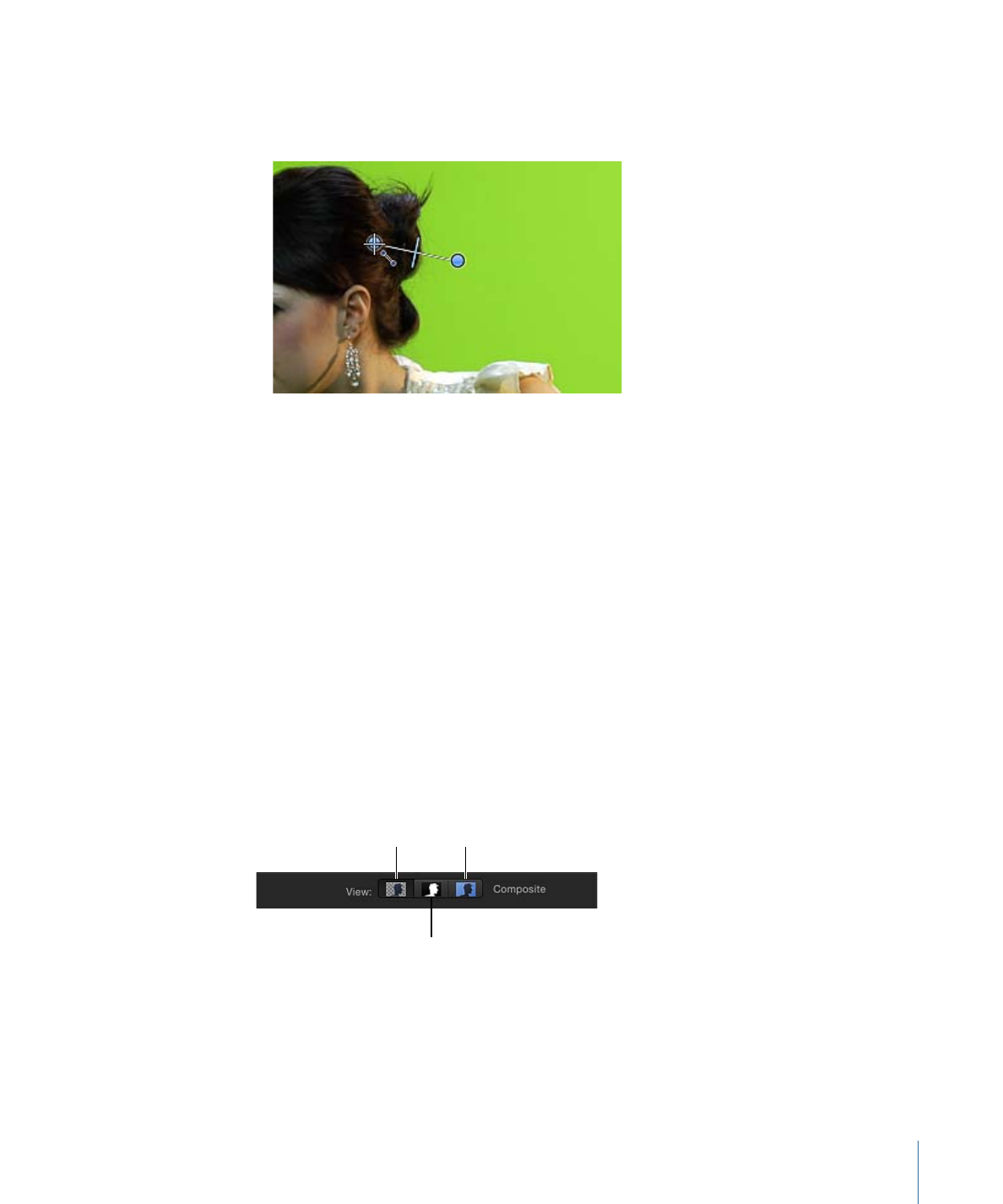
Note: To remove a Sample Color selection box or Edges control, select the box or
control, then press Delete. Alternatively, Option-click inside the selection box or control
line.
Strength:
Use this slider to adjust the tolerance (core transparency) of the Keyer filter’s
automatic sampling. The default value is 100%. Reducing this value narrows the range
of color sampled, resulting in less transparency in the keyed image. Increasing the Strength
value expands the range of color sampled, resulting in more transparency in the keyed
image. The Strength parameter is useful to retrieve areas of semitransparent detail such
as hair, smoke, or reflections.
Important:
Setting Strength to 0 bypasses the filter’s automatic sampling altogether,
allowing you to manually sample a range of color using the Refine Key tools.
Jump to Sample:
Use these left and right arrow buttons to navigate to frames that have
been manually sampled using the Sample Color and Edges tools. When the playhead is
at a sampled frame, a numeric counter to the right of these buttons indicates your current
position in the range of sampled frames (for example, “3 of 5”).
View:
Use these buttons to switch between three keying preview modes in the Canvas,
useful for refining your key. The View setting affects what is rendered in your final output.
For example, setting View to Matte lets you export a grayscale matte image that you can
use as a luma channel matte in another application. There are three buttons:
Composite
Original
Matte
• Composite: When selected, the leftmost button displays the final composited image
in the Canvas, with the keyed foreground object isolated against a transparent
background, which lets layers underneath show through.
639
Chapter 13
Keying

• Matte: When selected, the middle button displays the grayscale matte, or alpha channel,
generated by the keying operation. Viewing the alpha channel directly lets you evaluate
the parts of the generated matte. Areas in the matte that appear white are visible in
the final composite; areas that appear black are transparent; and areas with shades of
gray are semitransparent (lighter grays being more solid, and darker grays being more).
Viewing the alpha channel makes it easier to spot unwanted holes in the key, or areas
of the key that aren’t transparent enough.
• Original: When selected, the rightmost button displays the original, unkeyed image in
the Canvas. This view is useful to sample colors from the original image.
Fill Holes:
Use this slider adjust solidity in regions of marginal transparency throughout
a key. This parameter is useful when you’re satisfied with the edges of your keyed matte,
but you have unwanted holes in the interior of the foreground subject that you can’t
eliminate using the Strength parameter without ruining your edges. Higher slider values
fill more holes in the solid areas of the keyed subject.
Edge Distance:
Use this slider to adjust how close to the edge of your keyed subject the
effect of the Fill Holes parameter gets. Decreasing this parameter brings the solid,
nontransparent area of the matte closer to the edge of the subject being keyed, sacrificing
translucence at the edges in favor of filling unwanted holes at the edge of the keyed
subject, or retrieving areas of semitransparent detail, such as hair, smoke, or reflections.
Increasing this parameter pushes the filled area of the matte further to the interior of the
subject, away from the edges, adding translucence to regions of the image that aren’t
being keyed aggressively enough. Increasing this parameter too much may introduce
regions of unwanted translucence in parts of the subject that should be solid.
Spill Level:
Use this slider to set how much spill suppression is applied to the keyed
subject. Spill suppression is a color correction that neutralizes the green or blue colored
light that often bounces off a green screen or blue screen background and tints the edges
of a subject during a shoot. Consequently, it becomes more difficult to separate the
foreground subject from the background during the keying process. Spill suppression is
applied when you add the Keyer filter.
With spill suppression
Without spill suppression
640
Chapter 13
Keying
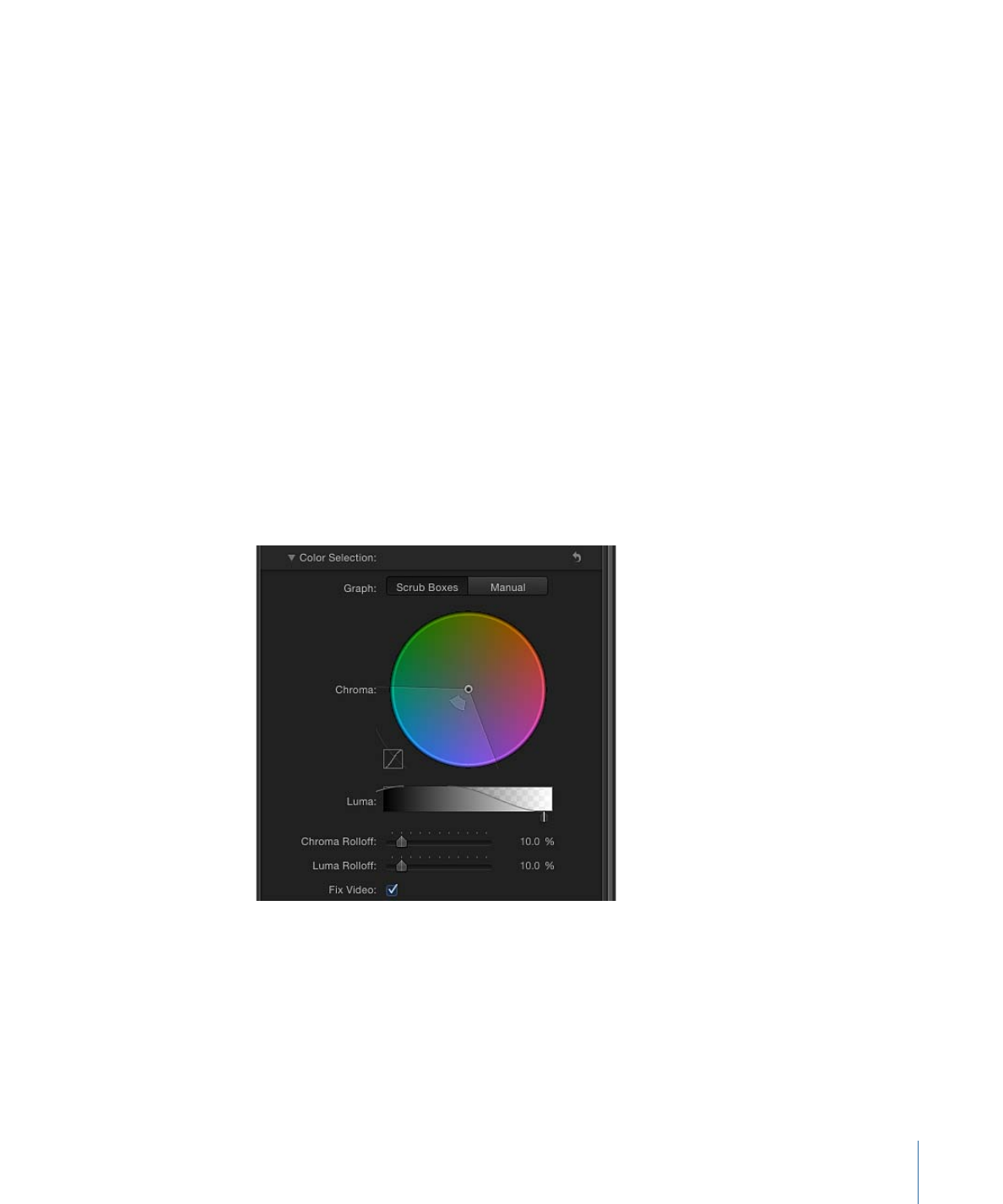
The color that’s suppressed in the final image is based on the sampled portion of the
image. The Spill Level slider controls how much spill suppression is applied to the keyed
subject. For example, if the subject was shot in front of a green screen background,
increasing the Spill Level value adds magenta to the foreground image, which neutralizes
any unwanted green cast that your subject may be exhibiting. Spill suppression can be
further customized using the controls in the Spill Suppression group, described later.
Setting Spill to 0 turns off spill suppression.
Invert:
Select this checkbox to Invert the generated matte, so solid areas become
transparent, and vice versa.
Color Selection:
Click the disclosure triangle in the Color Selection row to reveal controls
for adjusting the tolerance (core transparency) and softness (edge transparency) in the
chroma and luma channels of the keyed region. Which controls are adjustable depends
on the Graph mode (Scrub Boxes or Manual) you select in this group of controls.
These controls are meant to be used after you begin creating a key using automatic
sampling or the Sample Color and Edges tools. (However, you can skip those tools and
create a key using the Color Selection controls in Manual mode.) The graphical Chroma
and Luma controls in the Color Selection group provide a detailed way of refining the
range of hue, saturation, and image lightness that define the keyed matte.
641
Chapter 13
Keying

Before you adjust these controls, the graphs in the Chroma and Luma controls represent
ranges of color and luma in the image that have been automatically and manually sampled
(using the Refine Key tools and the Strength slider).
• Graph: Select one of two buttons to set how the adjustable graphs in the Chroma and
Luma controls are used to fine-tune a key:
• Scrub Boxes: Select this button to limit the Chroma and Luma controls to adjusting
softness (edge transparency) in the matte you are creating. In Scrub Boxes mode,
you cannot manually adjust tolerance (core transparency), which is determined by
the Keyer filter’s automatic sampling, plus any Sample Color selection boxes you’ve
added in the Canvas. To increase matte tolerance, add more Sample Color selection
boxes or adjust the Strength slider.)
• Manual: Select this button to use the Chroma and Luma controls to adjust the softness
(edge transparency) and tolerance (core transparency) in the matte you are creating.
Make sure the Strength slider is set to a value greater then 0 before you switch into
Manual mode, otherwise the Chroma and Luma controls are disabled. When you
switch to Manual mode, the Refine Key tools and Strength slider become disabled,
but samples you’ve made with those controls continue to contribute to the matte.
Important:
When you switch to Manual mode, it’s inadvisable to switch back to Scrub
Boxes mode. For best results, begin keying an image using the Sample Color and Edges
tools in Scrub Boxes mode. Switch to Manual mode afterwards if you feel it’s necessary
to refine your matte using the Chroma and Luma controls. However, after you switch
to Manual mode, do not switch back to Scrub Boxes mode. If you do, you may
experience unexpected combinations of additionally sampled and keyframed values
that might be difficult to control.
• Chroma: Drag the two graphs in this color wheel control to adjust the isolated range
of hue and saturation that help define the keyed matte. The selected mode governs
which graphs in the color wheel are adjustable. The outer graph controls the softness
(edge transparency) of the matte you’re creating, and can be adjusted in either Scrub
Boxes or Manual mode. The inner graph controls tolerance (core transparency), and is
only adjustable when in Manual mode.
Drag any side of either graph to expand or contract the graph’s border, which adds to
or subtracts from the range of hue and saturation contributing to the key. In manual
mode, you can also drag inside the tolerance graph to adjust its overall position in the
color wheel.
To the left of the color wheel, a small graph displays the slope of chroma rolloff, the
relative softness of matte edges in regions most affected by the Chroma control.
Dragging the Chroma Rolloff slider (described below) modifies the shape of this slope.
642
Chapter 13
Keying

It’s possible to zoom into and pan around the Chroma control to more precisely adjust
the graphs:
• Zooming the Chroma control: To zoom incrementally into the Chroma control, hold
down the Z key and click the color wheel. To zoom out, hold down the Option and
Z keys and click the color wheel. To smoothly zoom out, hold down the Z key and
drag left in the color wheel. To smoothly zoom in, hold down the Z key and drag
right in the color wheel. You can also hold down the Space bar and Command key
(in that order), and drag left in the color wheel to zoom out or drag right to zoom
in.
• Panning the Chroma control: To pan in the Chroma control, hold down the H key and
drag in the color wheel. You can also hold down the Space bar and drag in the color
wheel in the direction you want to move it.
To reset the zoom and recenter the Chroma control, move the pointer over the Chroma
control and press Shift-Z.
• Luma: Drag the adjustable handles in this grayscale gradient to modify the isolated
range of the luma channel (the range of lightness and darkness) that also helps define
the keyed matte. The upper handles (which only appear in Manual mode) adjust the
tolerance (core transparency) of the luma channel's contribution to the key. The lower
handles adjust the softness (edge transparency) of the luma channel's contribution to
the key.
The Graph mode governs which handles are adjustable. In Scrub Boxes mode, you can
adjust only the lower softness handles, which modify the range of lightness and darkness
affecting the edge transparency the matte. In addition to using the handles, you can
drag the slope in the graph to adjust the softness.
In Manual mode, you can also adjust the upper tolerance handles, which modify core
transparency within the luma channel of the matte. Dragging the slope in the graph
adjusts the lower handles (the softness). To adjust all handles simultaneously, drag
inside the curve in the graph.
By default, the slope of the left and right sides of the Luma graph has a slight “S” curve.
You can modify the shape of the curve by adjusting the Luma Rolloff slider (described
below).
Note: The luma softness handles may extend past the outer boundaries of the Luma
control. This is due to the floating-point precision of the Keyer filter, and is an expected
behavior.
• Chroma Rolloff: Use this slider to adjust the linearity of the chroma rolloff slope
(displayed in the small graph to the left of the Chroma control). Chroma rolloff modifies
the softness of the matte around the edges of regions that are affected most by the
Chroma control. Lowering this value makes the slope of the graph more linear, which
softens the edges of the matte. Raising this value makes the slope of the graph steeper,
which sharpens the edges of the matte.
643
Chapter 13
Keying
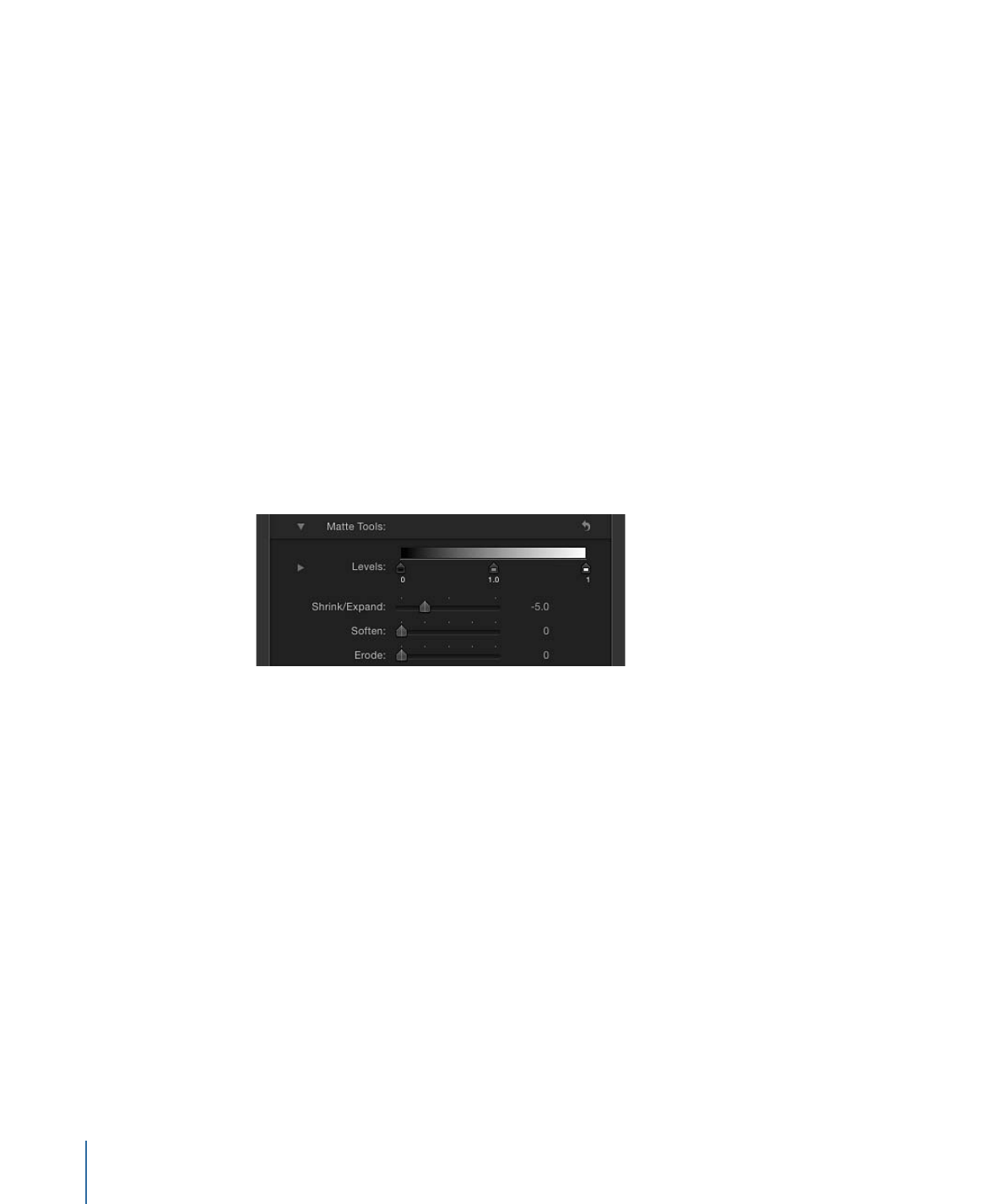
• Luma Rolloff: Use this slider to adjust the linearity of the luma rolloff slope (the ends
of the bell-shaped luma curve displayed in the Luma control). Luma rolloff modifies
the softness of the matte around the edges of regions that are affected most by the
Luma control. Lowering this value makes the slope between the upper and lower
handles in the Luma control more linear, which increases edge softness in the matte.
Raising this value makes the slope steeper, sharpening the edges of the matte and
making them more abrupt.
• Fix Video: Select this checkbox to apply subpixel smoothing to the chroma components
of the image, reducing the jagged edges that result from keying compressed media
using 4:2:0, 4:1:1, or 4:2:2 chroma subsampling. Although selected by default, this
checkbox can be deselected if subpixel smoothing degrades the quality of your keys.
Matte Tools:
Click the disclosure triangle in the Matte Tools row to reveal controls for
post-processing the transparency matte generated by the previous sets of parameters.
These parameters don’t alter the range of values sampled to create the keyed matte.
Instead, they alter the matte generated by the Keyer filter’s basic and advanced controls
(the Color Selection parameter group), letting you shrink, expand, soften, or invert the
matte to achieve a better composite.
• Levels: Use this grayscale gradient to alter the contrast of the keyed matte, by dragging
three handles that set the black point, white point, and bias (distribution of gray values
between the black point and white point). Adjusting the contrast of a matte can be
useful for manipulating translucent areas of the key to make them more solid (by
lowering the white point) or more translucent (by raising the black point). Dragging
the Bias handle right erodes translucent regions of the key, while dragging the Bias
handle left makes translucent regions of the key more solid.
• Black, White, Bias: Click the disclosure triangle in the Levels row to reveal sliders for the
Black, White, and Bias parameters. These sliders, which mirror the settings of the Levels
handles described above, allow you to keyframe the three Levels parameters (via the
Add Keyframe button to the right of each slider). Keyframing the Black, White, and Bias
parameters may yield a better key, one that adapts to changing blue screen or green
screen conditions.
644
Chapter 13
Keying
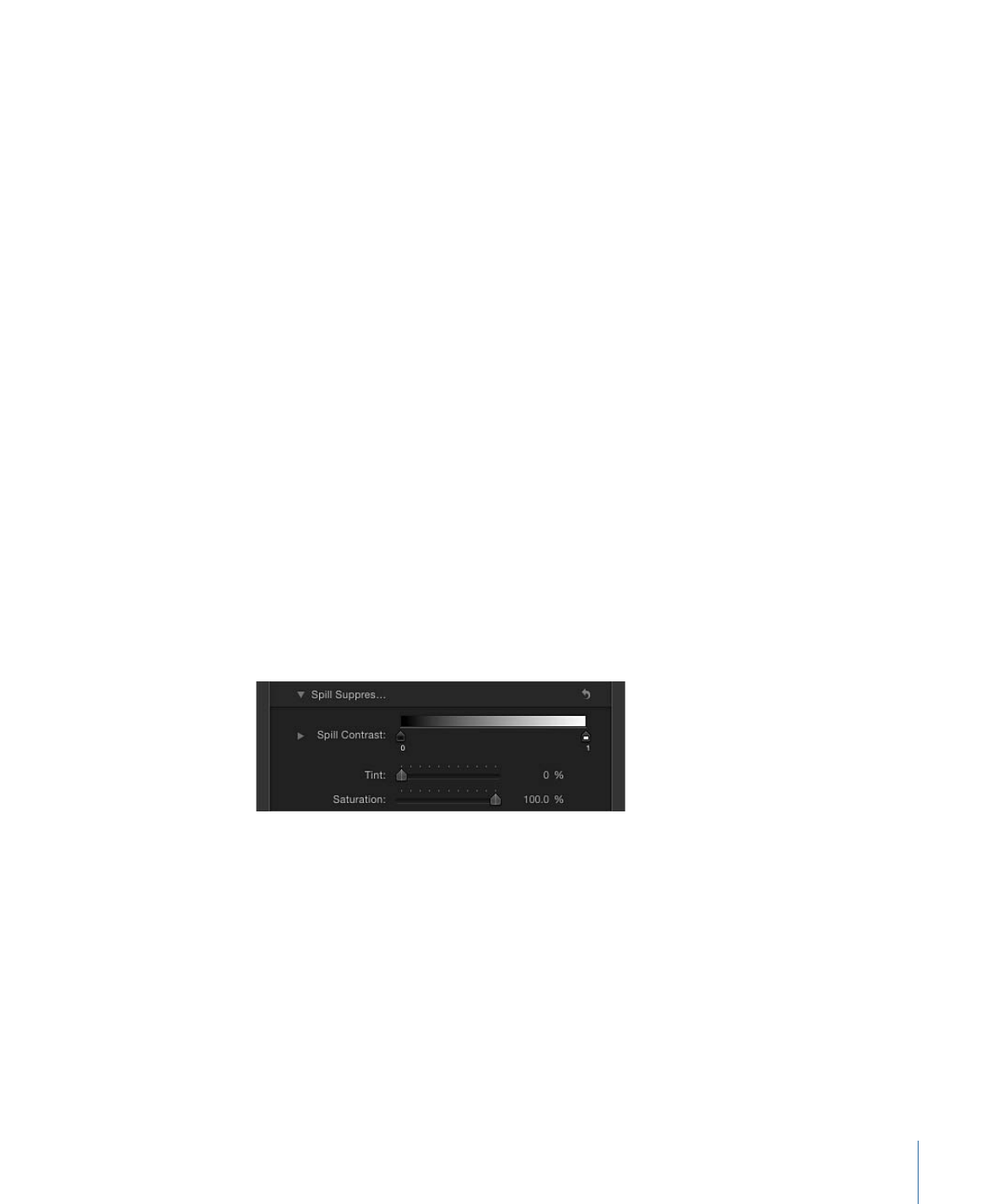
• Shrink/Expand: Use this slider to manipulate the contrast of the matte to affect matte
translucence and matte size simultaneously. Drag the slider left to make translucent
regions more translucent while simultaneously shrinking the matte. Drag the slider
right to make translucent regions more solid while simultaneously expanding the matte.
• Soften: Use this slider to blur the keyed matte, feathering the edges by a uniform
amount.
• Erode: Drag this slider right to gradually increase transparency from the edge of the
solid portion of the key inward.
Spill Suppression:
Click the disclosure triangle in the Spill Suppression row to reveal
controls for neutralizing a colored light that bounces off the blue screen or green screen
and contaminates the isolated foreground subject. This fringing around the edge of the
subject is called spill, and is difficult to eliminate because it’s part of the subject you’re
trying to preserve.
The Spill Suppression controls work by letting you adjust the color correction that
neutralizes unwanted color in the foreground subject. While the Spill Level slider (described
above) controls how much suppression is applied, the controls in this group let you
customize the quality of suppression being performed.
When first applied, the Keyer filter adds spill suppression to the video clip or image, based
on the dominant color sampled to create the initial key. This automatic spill suppression
desaturates the key color so fringing around the foreground subject appears gray (rather
than blue or green). But if you reduce the Spill Level slider to 0, effectively turning off
spill suppression, the gray fringing turns blue or green (the color of your background),
proving that successful spill suppression is rendering the background a neutral gray.
• Spill Contrast: Use this grayscale gradient to adjust the contrast of the color being
suppressed, using Black and White point handles (and corresponding sliders). Modifying
spill contrast can reduce the gray fringing surrounding a foreground subject. The Black
point handle (on the left side of the gradient control) lightens edge fringing that is too
dark for a successful composite. The White point handle (on the right side of the gradient
control) darkens edge fringing that is too light. Depending on how much spill is
neutralized by the Spill Level slider, these controls may have a greater or lesser effect
on the subject.
645
Chapter 13
Keying
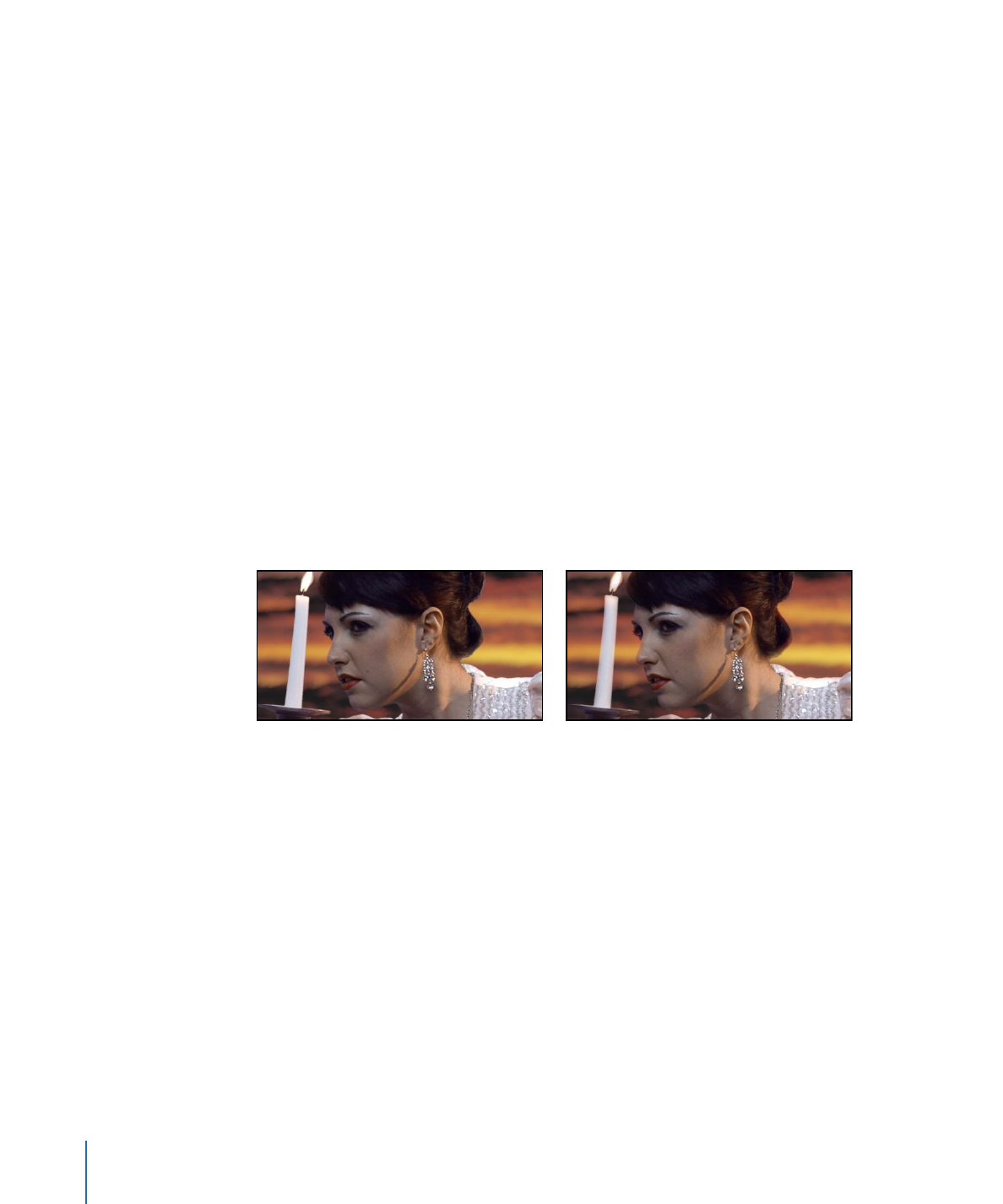
• Black, White: Click the disclosure triangle in the Spill Contrast row to reveal sliders for
the Black and White point parameters. These sliders, which mirror the settings of the
Spill Contrast handles described above, allow you to keyframe the Black point and
White point parameters (via the Add Keyframe button to the right of each slider).
• Tint: Use this slider to restore the natural color of the keyed foreground subject. Because
the Spill Suppression controls eliminate blue or green spill by desaturating subtle blue
or green fringing and reflection on the subject, the Tint slider lets you add hues to
restore the natural color of the subject. Overdoing this parameter results in over-tinting
the subject with the complementary color of the hue being suppressed—magenta if
green, and orange if blue.
• Saturation: Use this slider to alter the range of hues introduced by the Tint slider (when
the Tint slider is used at moderate levels).
Light Wrap:
Click the disclosure triangle in the Light Wrap row to reveal controls for
blending color and lightness values from the background layer of your composite with
the keyed foreground layer. Using these controls, you can simulate the interaction of
environmental lighting with the keyed subject, making it appear as if background light
wraps around the edges of a subject. In the following image on the right, with Light Wrap
applied, environmental lighting from the orange sky background layer appears on the
edges of the candle and on the top of the woman’s dress.
Without Light Wrap
With Light Wrap
In Motion, the Light Wrap operation blends light and dark values from the background
with the edges of the keyed foreground subject, and can be used to create color mixing
effects around the edges of the solid part of a key to better marry the background and
foreground layers of your keyed composite.
Light Wrap is the last operation in the image-processing pipeline. In other words, the
light-wrap effect is added after every other image operation is processed, including filters,
lights and shading, and other composited effects. As a result, Light Wrap properly accounts
for any other visual effect that might alter the look of the object it is applied to, yielding
the most desirable result.
646
Chapter 13
Keying
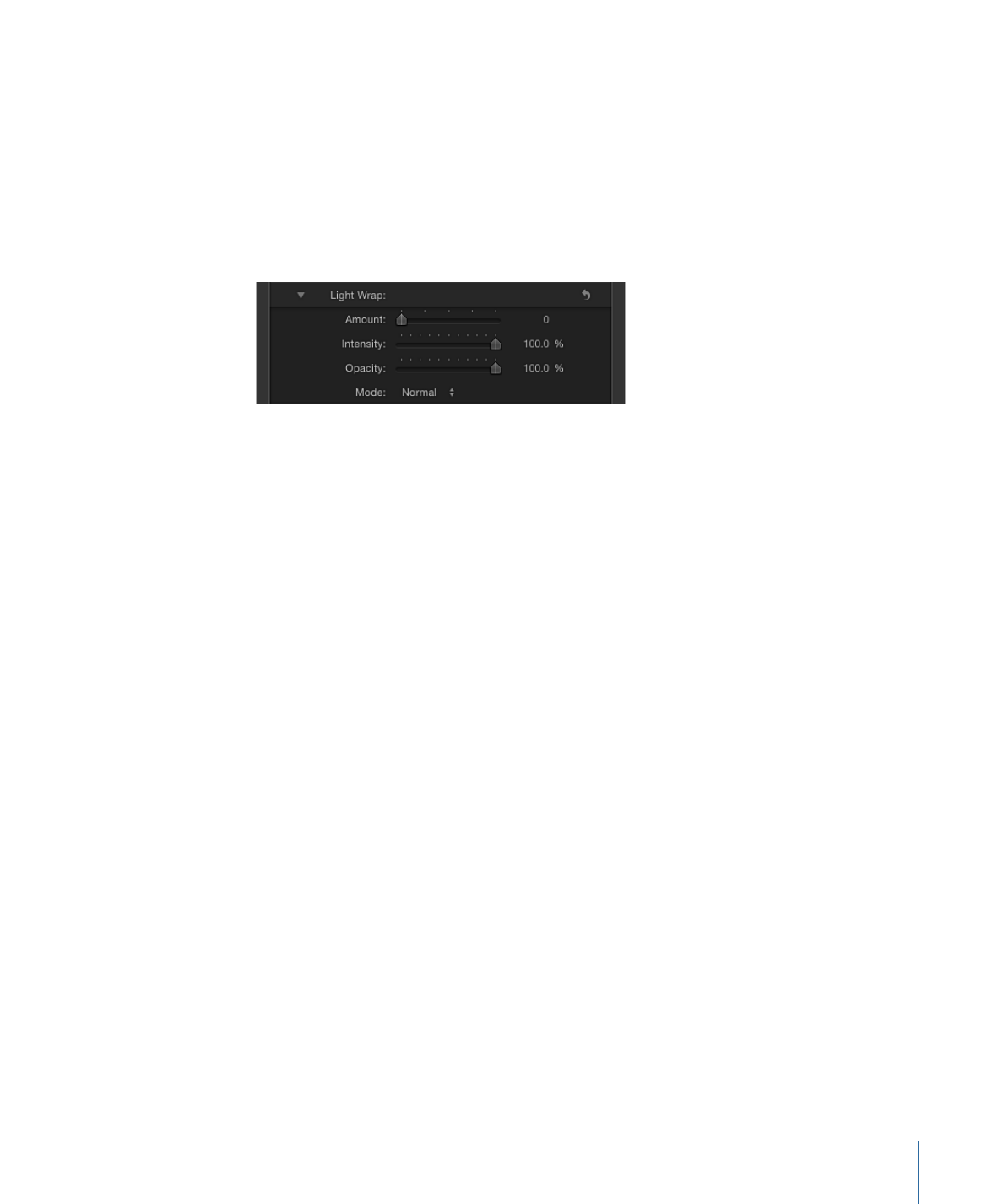
Important:
A separate Light Wrap option appears in the Blend Mode pop-up menu of
the Properties Inspector for selected layer or group in Motion. The Light Wrap blend
mode in the Properties Inspector for a layer is ignored when you add a Keyer filter to that
layer and set the Light Wrap Amount parameter to a value greater then 0. (The Light
Wrap parameters of the Keyer filter take precedence.) However, if you set the Amount
parameter of the Light Wrap group to 0, the Light Wrap blend mode becomes active
again. Further, the Light Wrap blend mode in the Properties Inspector for a group overrides
the Light Wrap parameters of any Keyer filters in that group.
• Amount: Use this slider to control the overall light-wrap effect, setting how far into the
foreground the light wrap extends.
• Intensity: Use this slider to adjust gamma levels to lighten or darken the interaction of
wrapped edge values with the keyed foreground subject.
• Opacity: Use this slider to fade the light wrap effect up or down.
• Mode: Use this pop-up menu to choose the compositing method that blends the
sampled background values with the edges of the keyed subject. There are five modes:
• Normal: Evenly blends light and dark values from the background layer with the
edges of the keyed foreground layer.
• Lighten: Compares overlapping pixels from the foreground and background layers,
then preserves the lighter of the two. Good for creating a selective light wrap effect.
• Screen: Superimposes lighter portions of the background layer over wrapped areas
of the keyed foreground layer. Good for creating an aggressive light wrap effect.
• Overlay: Combines the background layer with the wrapped areas of the keyed
foreground layer so overlapping dark portions become darker, light portions become
lighter, and colors become intensified.
• Hard Light: Similar to the Overlay composite mode, except that colors become muted.
Mix:
Use this slider to set the percentage of the original image to be blended with the
keyed image. 100% is the fully keyed image, while 0% is the original, unkeyed image.
HUD Controls
The HUD contains the following controls: Strength, Jump to Sample, View, Fill Holes, Edge
Distance, Spill Level, and Invert.
647
Chapter 13
Keying